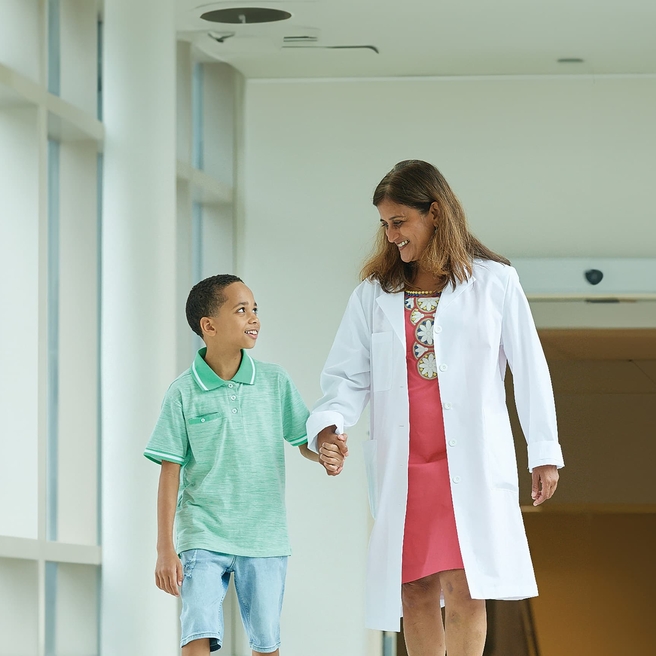What is congenitally corrected transposition of the great arteries?
Congenitally corrected transposition of the great arteries (CCTGA) is a rare heart defect affecting less than one percent of all people with congenital heart disease (CHD). This means there are only about 5,000 to 10,000 people in the United States with this condition.
In CCTGA, the heart’s pumping chambers (called ventricles) are reversed. The two main arteries that carry blood to the heart are also switched, so the heart is still able to function in a “corrected” way. That’s why the condition is called "congenitally corrected transposition of the great arteries." However, CCTGA is a complex malformation.
In a healthy heart, the left pumping chamber (left ventricle) sends blood to the entire body. The right pumping chamber (right ventricle) pumps blood only a short distance, to the lungs. The left ventricle is stronger than the right; it can work properly for up to 100 years if no other health problems exist. The right ventricle is not as strong.
In CCTGA, the heart twists abnormally while developing in the womb. The ventricles are reversed so that the left ventricle is on the right, and the right ventricle is on the left. This means the stronger left ventricle pumps blood to the lungs and the weaker right ventricle has the harder chore of pumping blood to the entire body.
This means that the right ventricle is working harder than it was designed to. If the right ventricle stops functioning effectively, a person with CCTGA will begin to develop symptoms.
There are several other problems that also occur in many patients with CCTGA. The most common are:
- A ventricular septal defect (VSD), which is a hole between the two pumping chambers of the heart
- Blockage of the blood on the way to the lungs (called pulmonary stenosis)
- An abnormal tricuspid valve that tends to leak
- A blockage in the heart’s electrical conduction system (which controls the heartbeat) that can lead to heart block and may require a pacemaker
Signs and symptoms of CCTGA
People with CCTGA experience a wide variety of symptoms, depending on other problems with the heart. Some newborns with complex forms of CCTGA have low oxygen levels and need care immediately after birth, but there are also healthy adults who can live a normal life for many years without any treatment.
CCTGA can be detected before birth by fetal echocardiography. If there are also problems with the size of the heart chamber or the function of the heart valves, then cardiac care may be needed immediately after birth.
In some cases, when the heart chamber sizes are normal and there are no other defects, CCTGA may not be diagnosed until adolescence or adulthood, when problems develop because of a leaky heart valve, abnormal heartbeat or the inability of the right ventricle to continue the hard work of pumping blood to the entire body.
Symptoms may include fainting or dizziness from heart block, or fatigue, as the heart becomes unable to pump enough blood to the body.
Testing and diagnosis of CCTGA
Diagnosis of CCTGA may require some or all of these tests:
- Echocardiogram (also called echo or ultrasound), in which sound waves create an image of the heart
- Chest X-ray
- Electrocardiogram (ECG), which records of the electrical activity of the heart
- Cardiac MRI, a 3D image that shows the heart’s structure
- Cardiac catheterization, during which a thin, flexible tube (catheter) is inserted through a vein or artery in the leg and into the heart to provide detailed information about the structure and function of the heart and lungs
Echocardiogram and cardiac MRI are used most often to diagnosis CCTGA.
Treatment for CCTGA
Treatment for CCTGA depends on the type and severity of symptoms and the defects causing them. Some children, especially those that have no additional heart defects, may not need treatment. However, even these children should be followed by a cardiologist for the rest of their lives so the condition can be monitored. For other children, medication may be needed.
For children that do need surgery, the type of operation depends on the child’s specific heart defects. There are several operations used to repair this condition. Here are a few.
- If there’s a hole in the heart (VSD), or if pulmonary stenosis develops, doctors may need to close the hole or insert a tube (called a conduit) between the heart and lungs. The conduit may need to be replaced or made bigger as time passes, which would require another surgery.
- If the VSD is left open, doctors might treat the heart as if it has only one pumping chamber (ventricle). This is called a “single ventricle” or Fontan repair. In this procedure, the veins that carry blood without oxygen are connected directly to the lungs, so the blood can pick up oxygen without having to pass through the heart.
- Doctors may perform a double switch operation, during which surgeons redirect blood flow from one side of the heart to the other. The heart's major arteries are also switched during this operation. This corrects the blood flow patterns, so that the heart's stronger left side delivers blood to the body and the weaker right side sends blood to the lungs. This is a very complex operation and is usually only performed on infants and children. It is very rarely used in adults.
Any of these operations may also include valve replacement with an artificial valve and/or placing a pacemaker.
The Cardiac Center at CHOP is a high-volume cardiac center, which means our highly experienced surgeons are experts at complex and difficult surgeries like Fontan and the double switch operation, with outcomes among the best in the world.
Outlook for CCTGA
Because of enormous strides in medicine and technology, today many children born with CCTGA go on to lead healthy, productive lives as adults. Overall, outcomes are usually better for babies born without additional heart defects.
Follow-up care
CCTGA is a complex heart condition. Some related complications begin and can be treated early in childhood, but other complications develop later in life. CCTGA requires life-long care by a cardiologist experienced in congenital heart disease.
Our pediatric cardiologists follow patients until they are young adults. The American College of Cardiology has recommended that CCTGA patients be seen regularly at regional ACHD centers. The Philadelphia Adult Congenital Heart Center, a joint program of CHOP and Penn Medicine, meets the unique needs of adults who were born with heart defects.
At CHOP’s Cardiac Center, we support our adolescent and young adult patients through a smooth and seamless transition to adult cardiology care at the Philadelphia Adult Congenital Heart Center or, if desired, to a cardiologist with congenital heart disease expertise in another location.

Why Choose Us
Our specialists are leading the way in the diagnosis, treatment, and research of congenital and acquired heart conditions.
Resources to help
Cardiac Center Resources
We know that caring for a child with a heart condition can be stressful. To help you find answers to your questions – either before or after visiting the Cardiac Center – we’ve created this list of educational health resources.
Reviewed by Amanda J. Shillingford, MD, FACC
Reviewed on 10/12/2024
